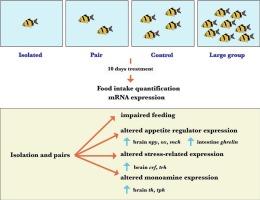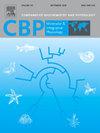群体大小对虎倒钩摄食行为、食欲、应激及神经递质相关转录物表达的影响
IF 2.2
3区 生物学
Q4 BIOCHEMISTRY & MOLECULAR BIOLOGY
Comparative Biochemistry and Physiology A-Molecular & Integrative Physiology
Pub Date : 2025-08-02
DOI:10.1016/j.cbpa.2025.111915
引用次数: 0
摘要
虎刺鱼(Puntigrus tetrazona)是典型的浅水鱼,在小群体中会变得有压力和攻击性。为了研究群体大小是否影响摄食,研究人员将鱼分成1、2、4或8组,每个鱼缸分别饲养,并在10天内进行监测。每天评估总体摄食行为、摄食潜伏期和摄食量。在这些条件下10天后,取鱼肠和脑样本进行转录物表达分析。被检测的基因包括食欲调节因子,如神经肽Y-npy、食欲素和黑色素浓缩激素(主要存在于大脑中),以及胆囊收缩素和肠中的胃饥饿素。我们还分析了大脑中与社会行为和压力相关的激素(催产素-oxt、促肾上腺皮质激素释放因子-crf和促甲状腺激素释放激素-trh)以及与合成血清素(色氨酸羟化酶-tph)、多巴胺(酪氨酸羟化酶-th)和肾上腺素(多巴胺-β-羟化酶- dbh)相关的基因的表达。与所有其他组相比,孤立的鱼消耗的食物明显更少,并且表现出更长的觅食延迟。与4组的鱼相比,成对饲养的鱼也表现出摄取量减少和觅食潜伏期延长的现象。在肠道中,与大群鱼相比,分离鱼的ghrelin表达升高,而ccka和cckb的表达没有差异。在大脑中,与4组或8组的鱼相比,单独饲养和成对饲养的鱼的促食神经肽(npy, mch和orexin)的表达更高。在离体鱼中,应激和神经递质相关基因(crf、trh、th和tph1)的表达也显著升高。oxt、tph2、dbh或cart的表达没有明显的组大小效应。总的来说,我们的研究结果表明,小群体,特别是隔离,会损害摄食行为,上调氧合和应激相关基因的表达,突出了社会环境在调节鱼群生理和行为反应中的重要性。本文章由计算机程序翻译,如有差异,请以英文原文为准。

Group size influences feeding behavior and the expression of appetite, stress, and neurotransmitter-related transcript expression in tiger barb (Puntigrus tetrazona)
Tiger barbs (Puntigrus tetrazona) are typical shoaling fish that can become stressed and aggressive when kept in small groups. To examine whether group size affects feeding, fish were housed in groups of 1, 2, 4, or 8 individuals per tank and monitored over a 10-day period. Overall feeding behavior, latency to feed, and the amount of food consumed were assessed daily. After 10 days under these conditions, fish were sampled for intestine and brain for transcript expression analyses. Genes examined included appetite regulators such as neuropeptide Y-npy, orexin and melanin-concentrating hormone-mch in the brain and cholecystokinin-cck and ghrelin in the intestine. We also analyzed brain expression of hormones related to social behavior and stress (oxytocin-oxt, corticotrophin-releasing factor-crf and thyrotropin-releasing hormone-trh) and genes related to the synthesis of serotonin (tryptophan hydroxylase-tph) and dopamine (tyrosine hydroxylase-th) and epinephrine (dopamine-β-hydroxylase- dbh). Isolated fish consumed significantly less food and exhibited longer latency to feed compared to all other groups. Fish housed in pairs also showed reduced intake and longer feeding latency relative to those in groups of 4. In the intestine, ghrelin expression was elevated in isolated fish relative to those in larger groups, while no differences were observed in ccka or cckb expression. In the brain, expression of orexigenic neuropeptides (npy, mch, and orexin) was higher in isolated and pair-housed fish compared to those in groups of 4 or 8. Expression of stress- and neurotransmitter-related genes (crf, trh, th, and tph1) was also significantly elevated in isolated fish. No significant group-size effects were found for oxt, tph2, dbh, or cart expression. Overall, our results suggest that small group sizes, particularly isolation, impair feeding behavior and upregulate orexigenic and stress-related gene expression, highlighting the importance of social environment in regulating physiological and behavioral responses in shoaling fish.
求助全文
通过发布文献求助,成功后即可免费获取论文全文。
去求助
来源期刊
CiteScore
5.00
自引率
4.30%
发文量
155
审稿时长
3 months
期刊介绍:
Part A: Molecular & Integrative Physiology of Comparative Biochemistry and Physiology. This journal covers molecular, cellular, integrative, and ecological physiology. Topics include bioenergetics, circulation, development, excretion, ion regulation, endocrinology, neurobiology, nutrition, respiration, and thermal biology. Study on regulatory mechanisms at any level of organization such as signal transduction and cellular interaction and control of behavior are also published.

 求助内容:
求助内容: 应助结果提醒方式:
应助结果提醒方式:


